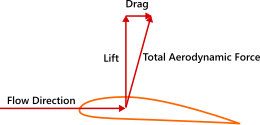
Back نسبة الرفع إلى السحب Arabic Аэрадынамічная якасць Byelorussian Аеродинамично качество Bulgarian Klouzavost Czech Glidetal Danish Gleitzahl (Flugzeug) German Relación entre sustentación y resistencia Spanish Finesse (aérodynamique) French יחס גלישה HE Finesa Croatian

In aerodynamics, the lift-to-drag ratio (or L/D ratio) is the lift generated by an aerodynamic body such as an aerofoil or aircraft, divided by the aerodynamic drag caused by moving through air. It describes the aerodynamic efficiency under given flight conditions. The L/D ratio for any given body will vary according to these flight conditions.
For an aerofoil wing or powered aircraft, the L/D is specified when in straight and level flight. For a glider it determines the glide ratio, of distance travelled against loss of height.
The term is calculated for any particular airspeed by measuring the lift generated, then dividing by the drag at that speed. These vary with speed, so the results are typically plotted on a 2-dimensional graph. In almost all cases the graph forms a U-shape, due to the two main components of drag. The L/D may be calculated using computational fluid dynamics or computer simulation. It is measured empirically by testing in a wind tunnel or in free flight test.[1][2][3]
The L/D ratio is affected by both the form drag of the body and by the induced drag associated with creating a lifting force. It depends principally on the lift and drag coefficients, angle of attack to the airflow and the wing aspect ratio.
The L/D ratio is inversely proportional to the energy required for a given flightpath, so that doubling the L/D ratio will require only half of the energy for the same distance travelled. This results directly in better fuel economy.
The L/D ratio can also be used for water craft and land vehicles. The L/D ratios for hydrofoil boats and displacement craft are determined similarly to aircraft.
- ^ Accurate calculation of aerodynamic coefficients of parafoil airdrop system based on computational fluid dynamic Wannan Wu, Qinglin Sun, Shuzhen Luo, Mingwei Sun, Zengqiang Chen and Hao Sun: International Journal of Advanced Robotic Systems
- ^ Validation of software for the calculation of aerodynamic coefficients Ramón López Pereira, Linköpings Universitet
- ^ In-flight Lift and Drag Estimation of an Unmanned Propeller-Driven Aircraft Dominique Paul Bergmann, Jan Denzel, Ole Pfeifle, Stefan Notter, Walter Fichter and Andreas Strohmayer
© MMXXIII Rich X Search. We shall prevail. All rights reserved. Rich X Search